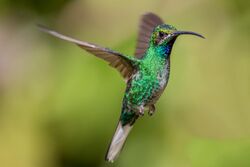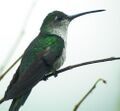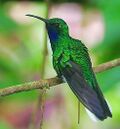Biology:Sabrewing
| Sabrewing | |
|---|---|

| |
| White-tailed sabrewing Campylopterus ensipennis | |
| Scientific classification | |
| Domain: | Eukaryota |
| Kingdom: | Animalia |
| Phylum: | Chordata |
| Class: | Aves |
| Clade: | Strisores |
| Order: | Apodiformes |
| Family: | Trochilidae |
| Tribe: | Trochilini |
| Genus: | Campylopterus Swainson, 1827 |
| Type species | |
| Trochilus latipennis[1] = Trochilus largipennis Latham, 1790
| |
| Species | |
|
10, see text | |
The sabrewings are relatively large Neotropical hummingbirds that form the genus Campylopterus. They are species of the understory and edges of forests, mostly in mountains, and often near streams. The female Sabrewing lays its two white eggs in a relatively large cup nest on a low horizontal branch, usually over a stream.
The sabrewings are very large for hummingbirds, typically 12–15 cm long. The black bill is strong and slightly decurved. The shafts of the male's two outermost primary flight feathers are thickened, flattened and bent at an angle to give the distinctive feature which gives the sabrewings their English and scientific names (Greek καμπυλος kampylos, "bent", and πτερον pteron, "wing").
In some species, the male and female plumage is similar, in others, such as the violet sabrewing, the sexes look completely different. In several species, the three outer pairs of the tail feathers are broadly tipped white.
The food of sabrewings is nectar, taken mainly from undergrowth flowers such as Heliconia and bananas.
Taxonomy
The genus Campylopterus was erected by the English naturalist William Swainson in 1827.[2] The type species was subsequently designated as the grey-breasted sabrewing.[3] The generic name combines the Ancient Greek kampulos meaning "curved" or "bent" and -pteros meaning "-winged".[4]
The sombre hummingbird and swallow-tailed hummingbird, formerly classified in Campylopterus, have been reclassified by most authorities into their own monotypic genera Aphantochroa and Eupetomena.
The genus contains 10 species:[5]
| Image | Name | Common name | Distribution |
|---|---|---|---|
 |
Campylopterus largipennis | Gray-breasted sabrewing | Amazon rainforest |
| Campylopterus diamantinensis | Diamantina sabrewing | Brazil | |
| Campylopterus calcirupicola | Outcrop sabrewing | Brazil | |
| 120px | Campylopterus hyperythrus | Rufous-breasted sabrewing | Brazil, Guyana, and Venezuela |
 |
Campylopterus ensipennis | White-tailed sabrewing | northeastern Venezuela and Tobago |
 |
Campylopterus falcatus | Lazuline sabrewing | Colombia, Ecuador, and Venezuela |
| 120px | Campylopterus phainopeplus | Santa Marta sabrewing | Colombia |
 |
Campylopterus hemileucurus | Violet sabrewing | southern Mexico and Central America as far south as Costa Rica and western Panama |
| Campylopterus duidae | Buff-breasted sabrewing | Brazil and Venezuela | |
 |
Campylopterus villaviscensio | Napo sabrewing | Colombia, Ecuador, and Peru |
References
- ↑ "Trochilidae". The Trust for Avian Systematics. https://www.aviansystematics.org/4th-edition-checklist?viewfamilies=80.
- ↑ Swainson, William John (1827). "On several groups and forms in ornithology, not hitherto defined". Zoological Journal 3: 343-363 [358]. https://biodiversitylibrary.org/page/27485884.
- ↑ Peters, James Lee, ed (1945). Check-list of Birds of the World. 5. Cambridge, Massachusetts: Harvard University Press. p. 18. https://biodiversitylibrary.org/page/14480029.
- ↑ Jobling, James A. (2010). The Helm Dictionary of Scientific Bird Names. London: Christopher Helm. p. 87. ISBN 978-1-4081-2501-4. https://archive.org/details/Helm_Dictionary_of_Scientific_Bird_Names_by_James_A._Jobling.
- ↑ Gill, Frank; Donsker, David; Rasmussen, Pamela, eds (January 2021). "Hummingbirds". IOC World Bird List Version 11.1. International Ornithologists' Union. http://www.worldbirdnames.org/bow/hummingbirds/. Retrieved 10 February 2021.
Wikidata ☰ Q535829 entry
 |

